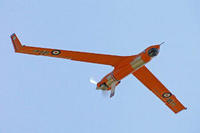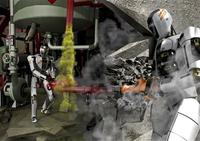-
Predicting sliding mountain slopes
If entire mountain slopes start to slide, danger threatens. It is not always easy to predict and monitor these mass movements. In an international project, scientists combined numerical models with microwave radar systems in Northern Tyrol — with promising results. The Steinlehnen slope in Northern Tyrol (Austria) started to move in 2003. Rockfalls threatened people, streets, and buildings. Meanwhile, peace has returned; although the slope is merely “creeping,” Steinlehnen has become an interesting research object for scientists in recent years.
-
-
App helps save people trapped by avalanche

For the person buried under the weight of an avalanche, each minute is precious. A person saved from the snow mass within fifteen minutes has a 90 percent chance of survival. After forty-five minutes that chance has diminished considerably. Researchers develop an app that makes it possible for skiers with smartphones to find people buried in the snow.
-
-
Smartphones to help find avalanche victims
Not a winter goes by without an avalanche incident. In the search for those buried beneath the snow, every second counts. On average, rescuers have fifteen minutes to recover victims alive. This is why an avalanche transceiver is an essential piece of kit for anyone spending significant time off-piste. These transceivers do not come cheap, however, ranging in price from 200 and over 500 euros — perhaps one reason why many walkers and skiers still do not carry one with them. Now smartphones equipped with functions of an avalanche transceiver should help locate the victims quickly.
-
-
Autonomous drones to help in search and rescue, disaster relief

Research could soon enable unmanned aerial vehicles (UAVs) to track down missing persons on search-and-rescue missions, to penetrate curtains of smoke during wildfire suppression, or possibly even to navigate urban landscapes on delivery runs for online retailers like Amazon. It all could be done autonomously with a human acting only as a supervisor. “Drones have gotten a very bad rap for various reasons,” says Kelly Cohen, associate professor of aerospace engineering and engineering mechanics at the University of Cincinnati. “But our students see that unmanned systems can have a positive impact on society.”
-
-
U.S. disaster preparedness threatened by funding problems
The 9/11 attacks in New York City prompted large increases in government funding to help communities respond and recover after man-made and natural disasters. This funding, however, has fallen considerably since the economic crisis in 2008. Furthermore, disaster funding distribution is deeply inefficient: huge cash infusions are disbursed right after a disaster, only to fall abruptly after interest wanes. These issues have exposed significant problems with our nation’s preparedness for public health emergencies. Researchers list seven recommendations to enhance preparedness for public health emergencies in the U.S.
-
-
Eight teams heading to DARPA Robotics Challenge finals

Two weeks ago, on 20-21 December 2013, sixteen teams were the main attraction at the DARPA Robotics Challenge (DRC) Trials, where they demonstrated their prototype robots’ ability to perform a number of critical real-world disaster-response skills. After two days of competition, the agency selected eight teams to receive up to $1 million in funding to continue their work and prepare for upcoming DARPA Robotics Challenge (DRC) Finals.
-
-
Seventeen teams to compete in DARPA Robotics Challenge Trials

Four teams that built full robot hardware and software systems using their own funds qualified to join thirteen other teams to compete in the Defense Advanced Research Projects Agency (DARPA) Robotics Challenge (DRC) Trials. The event will take place 20-21 December at the Homestead-Miami Speedway in Homestead, Florida, where spectators can observe as the robots are tested on the capabilities that would enable them to provide assistance in future natural and man-made disasters.
-
-
Standardized performance tests for emergency response robots
Seventeen teams will be directing their emergency-response robots to perform eight basic tasks which were drawn from the Fukushima Daiichi response and then converted into standardized tests by researchers at the National Institute of Standards and Technology (NIST). A year later, the capabilities of robots that qualify in this year’s trials will be tested in a more realistic disaster scenario. In the winner-take-all finals, robots will perform all eight challenges consecutively. NIST engineers have been at the forefront of using standardized performance testing for emergency response robots used in bomb-response and for urban search-and-rescue operations. Since 2005, fifteen NIST tests have been adopted as standards by ASTM International, and about forty more are under various stages of development or review.
-
-
Better earthquake early-warning system
Geophysicists have developed a new way of calculating the magnitude of an imminent earthquake by making better use of measurements of the compression waves produced early in the event. They say that the technique could be used to create a better early-warning system for earthquakes that could be used worldwide.
-
-
Smart software fighting fire with #fire
Australia’s key disaster management agencies have joined forces to tackle the problem of how to access and interpret information gathered during bushfires and other natural disasters to help emergency services save lives and property.
-
-
New drone to monitor radiation following nuclear disasters

Researchers have unveiled a large semi-autonomous drone called the ARM system which could be used to provide visual and thermal monitoring of radiation after a release of nuclear material. The system was developed in response to requirements for radiation monitoring in event of the release of radioactive materials.
-
-
Forecasting long-lived wildfires

Scientists have developed a new computer modeling technique that offers the promise, for the first time, of producing continually updated daylong predictions of wildfire growth throughout the lifetime of long-lived blazes. The technique combines cutting-edge simulations portraying the interaction of weather and fire behavior with newly available satellite observations of active wildfires.
-
-
Philippines prepares for worse disasters to come
On average, the Philippines experiences about twenty typhoons a year, including three super-typhoons and many incidents of flooding, drought, earthquakes, tremors, and occasional volcanic eruptions, making the country one of the most naturally disaster-prone areas in the world. Filipino government agencies, with the help of international disaster and relief agencies, have created new strategies for disaster preparedness, response, and mitigation which may well have potential applications in other parts of the world. As the impact of climate change grows more pronounced, the Philippines is becoming a hothouse for developing new methods and systems in the growing business of disaster relief.
-
-
Resources on disaster preparedness, resilience

One year after Superstorm Sandy hit the eastern United States, local, state, and federal agencies as well as community groups and businesses are working to strengthen the U.S.s resilience to future disasters. A National Research Council (NRC) has issues a series of studies and reports, and has put together workshops and study groups, which should advance the national conversation on preparedness and resilience.
-
-
The only effective asteroid defense: early detection – and evacuation of impact area

For the threat of meteor strikes large or small, early detection is key, and evacuation may be the only defense needed within the next 1,000 years, according to an asteroid impact expert. He says that the best investment in asteroid defense is not in weapons to deflect them, but in telescopes and surveys to find them.
-
- All
- Regional
- Water
- Biometrics
- Borders/Immig
- Business
- Cybersecurity
- Detection
- Disasters
- Government
- Infrastructure
- International
- Public health
- Public Safety
- Communication interoperabillity
- Emergency services
- Emergency medical services
- Fire
- First response
- IEDs
- Law Enforcement
- Law Enforcement Technology
- Military technology
- Nonlethal weapons
- Nuclear weapons
- Personal protection equipment
- Police
- Notification /alert systems
- Situational awareness
- Weapons systems
- Sci-Tech
- Sector Reports
- Surveillance
- Transportation
Advertising & Marketing: advertise@newswirepubs.com
Editorial: editor@newswirepubs.com
General: info@newswirepubs.com
2010-2011 © News Wire Publications, LLC News Wire Publications, LLC
220 Old Country Road | Suite 200 | Mineola | New York | 11501
Permissions and Policies
Editorial: editor@newswirepubs.com
General: info@newswirepubs.com
2010-2011 © News Wire Publications, LLC News Wire Publications, LLC
220 Old Country Road | Suite 200 | Mineola | New York | 11501
Permissions and Policies
